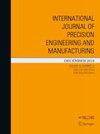热处理作用下TiO2纳米增强AA2024铝合金基纳米复合材料疲劳寿命的实验与数值研究
IF 2.6
4区 工程技术
Q2 ENGINEERING, MANUFACTURING
International Journal of Precision Engineering and Manufacturing
Pub Date : 2023-10-17
DOI:10.1007/s12541-023-00906-4
引用次数: 0
摘要
金属铝基纳米复合材料由于其高强度和高延展性,近年来越来越受到业界的关注。采用搅拌铸造的方法,将体积百分比为5wt . %的tio2纳米颗粒加入到AA2024合金中。采用新型粉末注射系统,将平均粒径为30±5 nm的tio2纳米颗粒加入到基体中。研究了热处理前后tio2含量对疲劳寿命的影响。结果表明:经过热处理后,纳米tio2的AA2024材料的疲劳性能有所提高。热处理后,当tio2浓度为5 wt. %时,合金的疲劳性能得到了最佳改善,与样品相比,疲劳寿命提高了14.71%。这是由于热处理后除均匀分布外,细小析出物数量增加所致。利用ANSYS有限元分析平台对纳米颗粒的加入对复合材料的疲劳寿命进行了研究。实验结果与数值疲劳强度吻合较好。对于复合材料,基体疲劳强度的实验值与数值值的差异不大于4%。结果还表明,时效后,枝晶间的无析出区消失或变小。然而,在加入5 wt. %的钛并进行热处理后,不可能析出Al 2 cu相,取而代之的是Al 3 TiCu和Al 7 TiCu相的析出相。本文章由计算机程序翻译,如有差异,请以英文原文为准。

Experimental and Numerical Investigations of the Fatigue Life of AA2024 Aluminium Alloy-Based Nanocomposite Reinforced by TiO2 Nanoparticles Under the Effect of Heat Treatment
Abstract Using aluminium metal matrix nanocomposites has recently gained increased attention in the industry due to their high strength and ductility. In this paper, TiO 2 nanoparticles in volume percentages of 5 wt. % were added to the AA2024 alloy using the stir casting method. Using a novel powder injection system, TiO 2 nanoparticles with an average particle size of 30 ± 5 nm was added to the matrix. The influence of TiO 2 content on the fatigue life before and after heat treatment was studied. The results showed the fatigue properties of AA2024 with TiO 2 nanoparticles increased after heat treatment. The optimum improvement in fatigue properties was obtained at 5 wt. % TiO 2 after heat treatment, with an improving fatigue life in 14.71% compared with sample based. This is due to an increased number of fine precipitates besides its uniformly distributed after heat treatment. The fatigue life of the composite materials with added nanoparticles was investigated using a finite element-based ANSYS workbench. There was a good match between what happened in the experiments and what happened to the numerical fatigue strength. For the composite materials, the difference between the experimental and numerical values of fatigue strength was not greater than 4% for the matrix. The results also, indicated that, after ageing, the precipitate-free zone at the inter-dendritic zone disappeared or became smaller. However, after adding 5 wt. % of titanium and, also, performing heat treatment, it is not possible to precipitate the Al 2 CuMg precipitates, and, instead of it, the Al 3 TiCu and Al 7 TiCu phases precipitates have been formed.
求助全文
通过发布文献求助,成功后即可免费获取论文全文。
去求助
来源期刊

International Journal of Precision Engineering and Manufacturing
ENGINEERING, MANUFACTURING-ENGINEERING, MECHANICAL
CiteScore
4.00
自引率
10.50%
发文量
115
审稿时长
5.4 months
期刊介绍:
The International Journal of Precision Engineering and Manufacturing accepts original contributions on all aspects of precision engineering and manufacturing. The journal specific focus areas include, but are not limited to:
- Precision Machining Processes
- Manufacturing Systems
- Robotics and Automation
- Machine Tools
- Design and Materials
- Biomechanical Engineering
- Nano/Micro Technology
- Rapid Prototyping and Manufacturing
- Measurements and Control
Surveys and reviews will also be planned in consultation with the Editorial Board.
 求助内容:
求助内容: 应助结果提醒方式:
应助结果提醒方式:


